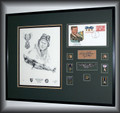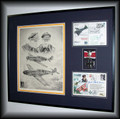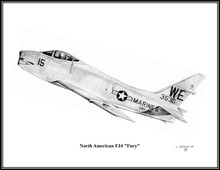 Loading... Please wait...
Loading... Please wait...Categories
Our Newsletter
- Home
- Combat Aircraft/Pencil Drawings ~ Free Shipping
- North American FJ4 "Fury" ~ Free Shipping
Product Description
***CLICK ON IMAGE TO ENLARGE***
Print Size 8½ x 11 ----- Unlimited print edition
FJ-4 Fury Work on the final naval Sabre, the "NA-209" or "FJ-4", began in December 1953, leading to award of contracts for two "NA-208" prototypes, followed by production contracts for 177 aircraft. First flight was on 28 October 1954. The FJ-4 was intended as an extended-range attack aircraft and was one of the most highly modified of the Sabre series. The airframe was completely redesigned to accommodate 50% more fuel, and the wing and tail were redesigned as well. Only the wingtips folded on the new wing. The landing gear was also redesigned and provided a wider track. Surprisingly, although the FJ-4 used basically the same powerplant as the FJ-3, a J65-W-16A engine with 34.2 kN (3,500 kgp / 7,720 lbf) thrust, the bigger FJ-4's performance matched or bettered that of its predecessor, a tribute to cleaner aerodynamics. The FJ-4 looked something like a Sabre on steroids, with a fatter fuselage, a redesigned canopy trailing into a dorsal spine running back to the tail, a wing wider at the root and narrower at the tip, and a taller tail. To reduce weight, some cockpit armor was removed, and the ammunition supply for the four 20 millimeter cannon was reduced to a total of 548 rounds. Four stores pylons were standard, and Sidewinders could be carried on all four pylons for the air-defense mission. The FJ-4 was also fitted with a midair refueling probe on the left wing. The "FJ-4B" sub-variant first flew in late 1956, and was further optimized for the low-level strike role. It had six stores pylons instead of four, two additional speed brakes, structural reinforcement to handle a greater weapons load, and a LABS installation for nuclear weapon delivery. The Navy introduced a "buddy tanker" refueling system 1957, allowing almost any aircraft capable of carrying external stores to carry a tank with a drogue-refueling line. This scheme greatly increased the effective range of carrier-based aircraft. Another late-1950s enhancement was the Martin "Bullpup" air-to-ground missile. The Bullpup was a radio-guided missile, which a pilot guided to a target up to 5 kilometers (3 miles) away by using a joystick to keep a flare on the end of the missile centered in his gunsight. An FJ-4B could carry five of these weapons, along with a guidance pack. First test firings of the Bullpup from FJ-4s were in 1957, with operational deployment in 1959. A number of FJ-4s were also modified to operate as control and chase aircraft for the Regulus, and these aircraft were designated "FJ-4Ds". An additional order for FJ-4s placed in 1956 gave a final total of 222 FJ-4s, with the last delivered in 1958, completing a total production of 1,112 Furies of all types. When the Navy adopted the tri-service aircraft designation scheme in September 1962, Furies still in service were redesignated as follows: By this time they were approaching the end of their days. Apparently a few FJ-4Bs performed air strikes into Laos in 1962, with one aircraft damaged so badly by anti-aircraft fire that it had to be written off after landing. This seems to have been the only combat service of any of the Furies. They were entirely in Reserve service by the end of 1962, and were completely out of service by the mid-1960s.
Warranty Information
null








